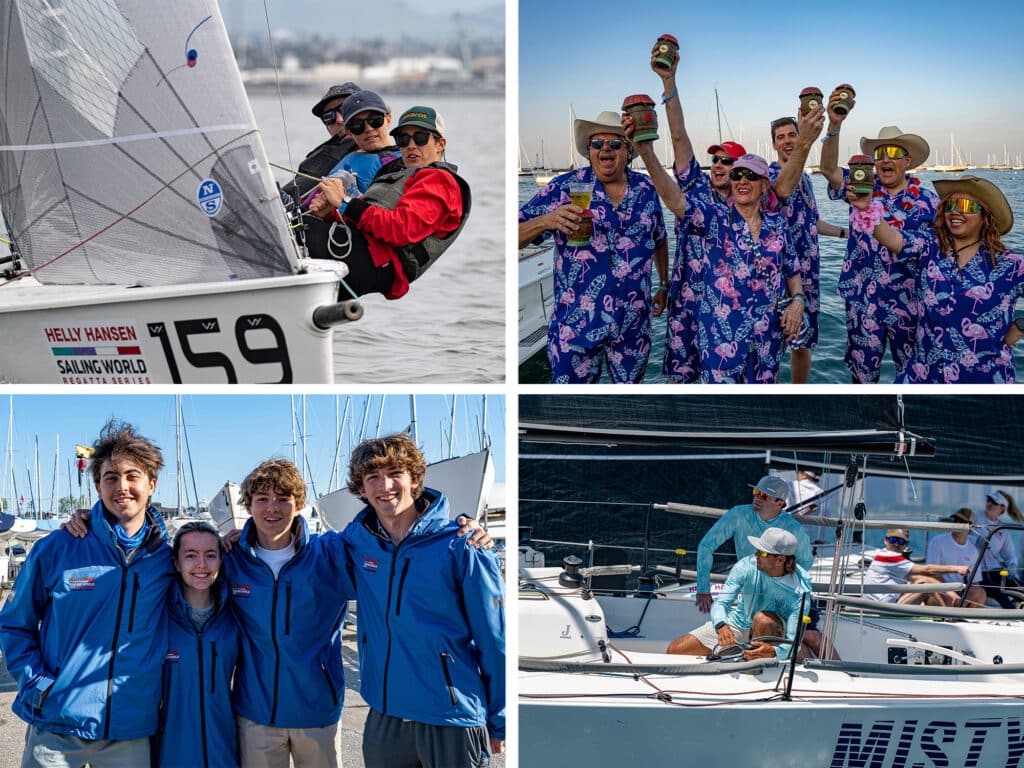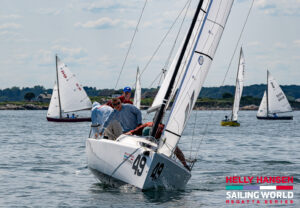
With the 2023 Helly Hansen Sailing World Regatta Series bidding farewell, and thanks to the sun-soaked action in St. Petersburg, Florida, in February, the series swapped coasts in March for the second stop in San Diego, birthplace of West Coast civilization and the California burrito, and a mecca of year-round sailing that churns out champions. Ninety-six boats across 13 fleets set out from the San Diego and Coronado yacht clubs each morning to the dual racecourses of San Diego Bay and the vast Pacific. On the ocean course, local Beneteau 36.7 sailors witnessed one of the greatest upsets in modern class history when Peter Cochran’s Rode Rage crew halted the 11-year regatta winning streak of Chick Pyle and his team on Kea. It was indeed a battle of the Bennies that came down to the final races. In the first, Rode Rage escaped from a crowded start and put up its first win of the day while Kea had to battle back from a botched start to finish third. It was enough for Cochran and company to simply cover Kea in the final race, and it was all said and done—until next time, Pyle says.
The San Diego regatta also featured Para Sailing for the first time, with Martin 16s and Hansa 303s trading tacks in the protection of Coronado’s Glorietta Bay. It was a sight to behold, with Hansa skipper Jim Thweatt using his Hansa series win to boost awareness of Para Sailing locally and abroad.
Next up came Annapolis, a hive of one-design racing that makes this Chesapeake Bay capital the sailing-crazed town it is. With 154 entries across 13 fleets, the regatta encompassed the most popular one-designs of the area: J/105s, J/22s and Viper 640s. It also featured the inclusion of two new-to-the-regatta doublehanded dinghy fleets: the modern Melges 15 and the classic Wayfarer Dinghy class, which has been active for decades in the US but assembled in Annapolis to join the fun and a challenging weekend of races.
Chicago is never one to be outsized. True to form, the only freshwater regatta of the series welcomed 162 teams and 15 fleets, as well as the DragonForce 65 remote-control racers, who traditionally provide the Saturday-night party entertainment. The addition of ILCAs and a special appearance by six-time Formula Kite world champion Daniela Moroz at the regatta’s Speaker Series were highlights for the area’s junior sailors. In the Windy City, the breeze cooperated for the most part and allowed the J/70s—the regatta’s biggest fleet—to put six quality races on the scoreboard over three days. Richard Wizel’s Rowdy won by an astonishing 15 points in a fleet stacked deep with talent; many teams were using multiple stops of the series as stepping stones to the J/70 World Championship in St. Petersburg in late October.
Straight from the bustle of Chicago’s vibrant lakefront, the series transitioned to the sleepy seaside town of Marblehead, Massachusetts, on the outskirts of Boston. With a harbor jam-packed with boats and locals soaking in the finest and waning days of their New England summer, the place was abuzz with 142 entries across 10 classes. On the waters of Massachusetts Bay, the Viper 640, J/70 and Town class fleets gathered to contest their New England Championship titles, with the big-fleet Vipers pulling in a top-shelf Canadian contingent. The return of the Lightning class to this edition of Marblehead Race Week—after a nearly 40-year absence—was celebrated by all, including National Sailing Hall of Fame inductee and local legend Dave Curtis, who made a rare appearance for the awards to present his trophy to Etchells fleet winner Thomas Hornos and his crew on Bob, which pulled a double by also winning the fleet’s Mixed-Plus Trophy.
The Mixed-Plus initiative is aimed at getting more women onto keelboats and into key roles. The effort began in St. Petersburg in 2022 and has been embraced across the sport and at each of the Helly Hansen Sailing World Regatta Series stops. Inclusion and diversity among the regatta’s sailors and fleets is the goal of sailing events director Sarah Renz. As the colors cannon boomed from Corinthian YC’s yardarm on a beautiful Sunday summer evening, the series drew to a fitting end, sun-kissed from start to finish and celebrated coast to coast, a national regatta series more diverse and exciting than ever.









